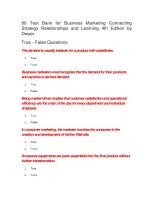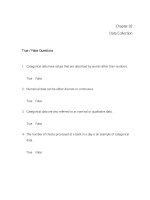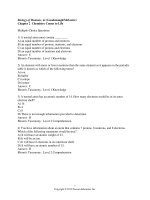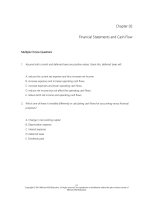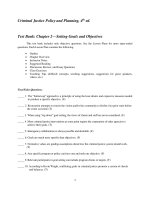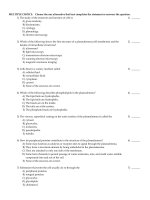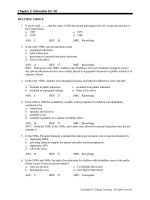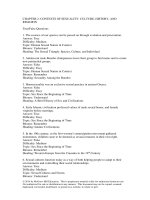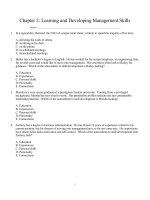Human Relationship Skills- Coaching and Self-Coaching (4th Edition)
Bạn đang xem bản rút gọn của tài liệu. Xem và tải ngay bản đầy đủ của tài liệu tại đây (1.03 MB, 280 trang )
Human Relationship Skills
Human Relationship Skills: Coaching and Self-Coaching presents a practical ‘how
to’ guide to relationship skills, showing how readers can improve and, where
necessary, repair relationships. This thoroughly revised and updated 4th edition
reflects the increased interest in coaching, showing how it can be applied to
everyday life.
In this essential book, Richard Nelson-Jones takes a cognitive-behavioural
approach to coaching people in relationship skills. These skills are viewed as
sequences of choices that people can make well or poorly. Covering a range of
skill areas the book assists readers to make affirming rather than destructive
choices in their relationships. It begins by addressing the questions of ‘What are
relationship skills?’ and ‘What are coaching skills?’, and follows with a series of
chapters which thoroughly detail and illuminate various relationship skills
including:
•
•
•
•
•
Listening and showing understanding.
Managing shyness.
Intimacy and companionship.
Assertiveness and managing anger.
Managing relationship problems and ending relationships.
The book concludes with a chapter on how users can maintain and improve
their skills by coaching themselves.
Accessibly written and using activities, the book is appropriate for those
involved in ‘life coaching’ as well as general counselling and therapy. It will be
essential reading for lecturers, coaches and trainers as well as students and anyone who wishes to improve their relationship skills.
Richard Nelson-Jones is a leading international author whose books have
helped train many thousands of psychotherapists, counsellors and helpers
worldwide. He has held university appointments in Britain and Australia, and is
a Fellow of the British and Australian Psychological Societies and of the British
Association for Counselling and Psychotherapy.
‘Many people do not possess the needed skills for positive interpersonal
relationships. This pragmatic handbook will allow you to help yourself and
others to gain mental health and happiness. I highly recommend this book and
hope that it is widely read.’
Jon Carlson, Distinguished Professor, Governors State University, Illinois
‘This excellent book comprehensively covers key human relationship skills.
During my workshops and lectures often I would recommend the earlier version
of this book as an aid to practitioners and their clients. This new revised
4th edition is even better, especially with its coaching and self-coaching
approach.’
Stephen Palmer, Director of the Centre for Coaching
‘Richard Nelson-Jones’s 4th edition will be my recommended text in my roles
as (tertiary education) lecturer, counsellor, and supervisor of mental health
professionals. His comprehensive skills training enables mastery and selfreliance in this essential field.’
Meredith Fuller, Counselling Psychologist, Lecturer, and
Supervisor of Mental Health Professionals
‘Richard Nelson-Jones has produced another of his excellent skills manuals –
this time inviting us to self-examine and self-improve on all the dimensions
of relationships. Richard’s writing is enriched with significant breadth of
knowledge of the wisdom of the field, but he offers his own special brand
of invitation to think of skills, and to reflect and work on ways to improve
those skills. With extraordinary attention to detail he uncovers many aspects of
relationships – shyness, assertiveness, sexuality among others. The exercises for
self-examination are demanding, intriguing, and enlightening. Very worthwhile
for counsellors, life coaches, and indeed for anyone who would like to reflect on
and improve their relationship skills.’
Ron Perry, Director, Institute of Counselling, Sydney
Human Relationship Skills
COACHING AND SELF-COACHING
4th edition
Richard Nelson-Jones
First published 1986 as Human Relationship Skills: Training and Self-help
by Cassell, London and by Holt Rinehart and Winston, Sydney
Second edition published 1990 as Human Relationship Skills: Training and
Self-help by Cassell, London and 1991 as Human Relationship Skills by Holt
Rinehart and Winston, Sydney
Third edition published 1996 as Relating Skills: A Practicle Guide to
Effective Personal Relationships by Continuum, London and as Human
Relating Skills by Harcourt Brace, Sydney
Fourth edition published 2006
by Routledge
27 Church Road, Hove, East Sussex BN3 2FA
Simultaneously published in the USA and Canada
by Routledge
270 Madison Avenue, New York, NY 10016
This edition published in the Taylor & Francis e-Library, 2006.
“To purchase your own copy of this or any of Taylor & Francis or Routledge’s
collection of thousands of eBooks please go to www.eBookstore.tandf.co.uk.”
Routledge is an imprint of the Taylor & Francis Group, an informa business
Copyright © 2006 Richard Nelson-Jones
All rights reserved. No part of this book may be reprinted or
reproduced or utilized in any form or by any electronic, mechanical
or other means, now known or hereafter invented, including
photocopying and recording, or in any information storage or
retrieval system, without permission in writing from the publishers.
This publication has been produced with paper manufactured to strict
environmental standards and with pulp derived from sustainable forests.
British Library Cataloguing in Publication Data
A catalogue record for this book is available from the British Library
Library of Congress Cataloging-in-Publication Data
Nelson-Jones, Richard.
Human relationship skills : coaching and self-coaching / Richard
Nelson-Jones. – 4th ed.
p. cm.
Previously published: Relating skills: a practical guide to effective personal
relationships. London : Continuum, 1996.
Includes bibliographical references and index.
ISBN 0-415-38586-5 – ISBN 0-415-38587-3 1. Interpersonal relations.
2. Social skills. 3. Personal coaching. I. Title.
HM1106.N45 2006
158.2–dc22
2005027114
ISBN13: 9-78-0-415-38586-2
ISBN13: 9-78-0-415-38587-9
ISBN10: 0-415-38586-5 (hbk)
ISBN10: 0-415-38587-3 (pbk)
Contents
List of activities
Preface
1. What are human relationship skills?
vi
viii
1
2. What are coaching skills?
17
3. Listening skills
36
4. Show understanding skills
55
5. Manage shyness skills
75
6. Choose a relationship skills
100
7. Intimacy skills
120
8. Companionship skills
140
9. Sexual relationship skills
159
10. Assertiveness skills
183
11. Manage anger skills
204
12. Manage relationship problems skills
221
13. End a relationship skills
241
14. Coach yourself
251
References
Name index
Subject index
259
265
267
Acti vities
Activity 1.1
Activity 1.2
Activity 1.3
Activity 1.4
Activity 2.1
Activity 2.2
Activity 2.3
Activity 3.1
Activity 3.2
Activity 3.3
Activity 3.4
Activity 3.5
Activity 4.1
Activity 4.2
Activity 4.3
Activity 4.4
Activity 4.5
Activity 5.1
Activity 5.2
Activity 5.3
Activity 5.4
Activity 5.5
Activity 6.1
Activity 6.2
Activity 6.3
Activity 6.4
Activity 7.1
Activity 7.2
Activity 7.3
Activity 7.4
Activity 7.5
Translate everyday into skills language
Send communication/action skills messages
Assess my mind skills
Group discussion: a relationship skills approach
Use demonstration skills
Use rehearsing skills
Use negotiating homework skills
Assess my barriers to an accepting attitude when
I listen
Tune into another’s internal viewpoint
How rewarding are my vocal messages when I listen?
How rewarding are my body messages when I listen?
Group discussion: listening skills
Develop my paraphrasing skills
Develop my reflecting feelings skills
Develop my questioning skills
Develop my challenging skills
Develop my mind skills
Assess how shy I am
Develop my conversation skills
Develop my making a date skills
Develop my mind skills to manage shyness
Group discussion: managing shyness skills
Assess and implement my search and find skills
Assess my mind skills weaknesses in choosing
a partner
What am I looking for in a partner?
Group discussion: choosing a partner skills
Develop my expressing feelings skills
Develop my disclosing and receiving personal
information skills
Develop our ‘you–me’ talk skills
Develop my mind skills for expressing intimacy
Group discussion: intimacy skills
10
12
13
16
28
31
35
43
45
48
51
54
57
61
66
69
72
77
82
84
96
98
103
111
117
119
126
129
131
137
138
vii
Activity 8.1
Activity 8.2
Activity 8.3
Activity 8.4
Activity 9.1
Activity 9.2
Activity 9.3
Activity 9.4
Activity 10.1
Activity 10.2
Activity 10.3
Activity 10.4
Activity 11.1
Activity 11.2
Activity 11.3
Activity 11.4
Activity 12.1
Activity 12.2
Activity 12.3
Activity 12.4
Activity 12.5
Activity 13.1
Activity 13.2
Activity 13.3
Activity 14.1
Activity 14.2
LIST OF ACTIVITIES
Identify and choose companionship and personal
activities
Develop my communication skills for companionship
Develop my mind skills for companionship
Group discussion: companionship skills
Degree of comfort with sexual activities
Develop my communication skills for relating
sexually
Develop my mind skills for relating sexually
Group discussion: sexual relationship skills
Assess my assertiveness skills
Develop my communication skills for being assertive
Develop my mind skills for being assertive
Group discussion: assertiveness skills
Assess my angry feelings
Develop my communication skills for managing
anger
Develop my mind skills for managing anger
Group discussion: managing anger skills
Become more accepting
Exchange rewarding behaviours
Use the CUDSA model for solving a relationship
problem
Stay in touch
Group discussion: manage relationship problem
skills
Communication skills for ending a relationship
Mind skills for ending a relationship
Group activity: ending a relationship and starting
again skills
Monitor my relationship skills
Coach myself in a relationship skill
146
151
157
158
167
172
180
182
185
196
202
202
206
211
219
220
225
229
237
239
239
245
248
250
252
258
Preface
Welcome to the fourth edition of Human Relationship Skills: Coaching and SelfCoaching. The following are answers to some questions you may have about the
book.
WHAT IS THIS BOOK’S PURPOSE?
This is a practical ‘how to’ book on coaching relationship skills. Written for
lecturers, trainers and coaches and those being lectured, trained and coached,
the book aims to show you how to improve and, where necessary, to repair
relationships. I aim to help you to gain greater relationship satisfaction and
prevent unnecessary distress and pain. Relationship skills are viewed as
sequences of choices in various skills areas that you can make well or poorly.
You can either support or oppress yourself and one another by the choices you
make. This book coaches you in how to make affirming rather than destructive
choices in your relationships.
FOR WHOM IS THIS BOOK INTENDED?
This book is intended for the following audiences.
•
•
•
Lecturers, trainers and coaches running relationship training and coaching
courses in colleges and universities, schools, adult education centres and in
non-educational settings. Such courses may be run in psychology departments – as an applied change from academic teaching – and in personnel
work, social work, education, nursing, personnel work, pastoral care and as
part of college general education programmes.
Students training for the helping services: for instance, as psychologists,
counsellors, social workers, nurses, personnel officers, teachers and pastoral
care workers.
Students in colleges, universities and adult education centres taking human
relations and human communication courses.
ix
•
•
•
•
•
PREFACE
Staff and individual clients and groups of clients in college counselling
centres. Many counselling centres run courses on aspects of human relationship skills.
Trainers and participants on marriage preparation and relationship coaching
courses run by voluntary and church-related agencies.
Students in the final years of secondary school.
Helping service professionals and voluntary agency counsellors for reference and for recommending to clients.
Singles and couples interested in improving their relationship skills by
means of self-help.
Though strongly supporting family values, I do not intend this book for those
wishing to learn more about family and parenting skills. Nevertheless, I hope the
book indirectly results in happier families and children.
WHAT ARE THIS BOOK’S CONTENTS?
The first chapter introduces the idea of people possessing a repertoire of relationship skills, each of which is composed of communication skills and mind
skills. The second chapter is the only one in the book written mainly for those
coaching and describes some central skills of being an effective coach. There
then follow 11 chapters to support the coaching of various important relationship skills: listening, show understanding, manage shyness, choose a relationship, intimacy, companionship, sexual relationship, assertiveness, manage anger,
manage relationship problems, and end a relationship skills. The final chapter
addresses the issue of coaching yourself and getting assistance in so doing. I have
put skills-building activities throughout the book.
WHAT FEATURES DOES THIS BOOK POSSESS?
•
•
•
•
•
Lifeskills emphasis. Human relationship skills are important lifeskills that
you can be coached in and learn well or poorly. Fortunately, you can keep
improving your skills. Throughout the book, I use the term relationship
skills rather than lifeskills.
Comprehensiveness. I offer a comprehensive coverage of the skills you
require for effective personal relationships. I break the sexual silence of
most texts on relationship skills by devoting a chapter to this important
topic.
Emphasis on mental cultivation. The book emphasizes personal responsibility,
courage and mental discipline. Nowhere do I encourage you to think that
relating well is always easy.
Anglo-Australian emphasis. Unlike most relationship coaching and education texts which are American, this book draws on British and Australian
demographic data, books, articles and research findings.
Practical activities. The book includes numerous practical activities to
x
•
•
PREFACE
help you as singles, partners or in groups develop your knowledge and
skills.
User-friendly format. Each chapter follows the same user-friendly format:
chapter outcomes, text and activities.
Readability. I have endeavoured to write the book in clear and simple
English.
A FINAL WORD
I hope the book articulates a vision of how to relate that resonates with you.
Good luck and, above all, good skills!
Richard Nelson-Jones
1
What are human relationship
skills?
Chapter outcomes
By studying and doing the activities in this chapter you should:
• gain some knowledge into what are relationships
• understand more about changing patterns of relationships
• be introduced to a skills approach to relationships
• be introduced to communication skills
• be introduced to mind skills
• understand the role of feelings and physical reactions.
Human relationship skills are the skills involved in human connection. All
human beings are biologically programmed to need other people, both for the
acts of conception and birth and then throughout their lives. Relationships
come with no guarantee of happiness and can be for good or ill, for pleasure or
pain. However, the more skilled you are at relating, the greater the likelihood
that you will maximize your own and others’ happiness and contribute less to
the sum of human misery and pain. We all like our relationships to be rewarding.
The following are examples of people who relate in rewarding ways.
Whenever Jim and Tricia come home from work, they may rest for
a short time, but then they always check with interest how each
other’s day has gone.
Chloe and Paul do not just enjoy their sexual relationship, they
also enjoy the companionship that comes from regularly kissing,
hugging, putting an arm over each other’s shoulders and holding
hands.
2
HUMAN RELATIONSHIP SKILLS
Though initially Lucy did not like visiting her partner Tony’s
parents regularly, she now goes over with him every other weekend and gets along well with them. Tony greatly appreciates the
effort she has made.
The following are examples of people relating in unrewarding ways.
Tom gets jealous because his wife Emma is having an animated
discussion with their friend Pete at a party. Later Tom angrily
accuses Emma of flirting with Pete, despite this not being the
case.
Often when Susan wants to make a point with Joe, she comes on
very strong which has the effect of making him withdraw from any
real discussion of situations.
Dave and Sophie rarely listen properly to each other any more,
even when one of them is trying to say something important in a
reasonable way.
In each of these examples, people used varying degrees of relationship skills.
Those who were giving and getting rewards in their relationships used their
relationship skills effectively to attain these ends. Those behaving in unrewarding ways failed to use good skills. In reality, people often use a mixture of good
and poor skills, though in good relationships skilled behaviour predominates.
WHAT ARE RELATIONSHIPS?
Connection is the essential characteristic of relationships. People in relationships
exist in some connection with one another, be it marriage, kinship, friendship or
acquaintance. Isolation or being placed apart from others is very different from
relationship, though even in isolation people can mentally relate to others. John
Donne, the Elizabethan, wrote in his Devotions upon Emergent Occasions (1624:
17): ‘No man is an Island, entire of it self; every man is a piece of the Continent,
a part of the main’. In short, humans are social animals who cannot avoid
relationships. We are condemned not only to exist, but to relate. However, in an
existential sense, humans are also condemned to isolation: for example, no one
can die another’s death for them. Out of their human separateness, humans
strive to relate.
Though relationships can be very brief, the term can imply a broader time
frame. Personal relationships are often long term and contain the expectation
that they will continue into the future. Feelings of attachment, commitment and
obligation, as well as of hatred and despair, can run very deep in such
relationships.
Inevitably relationships involve change. Over time, all people change in varying
3
WHAT ARE HUMAN RELATIONSHIP SKILLS?
ways and degrees. For instance, they age and develop different interests. Furthermore, how partners relate can contribute to changes in each of them, such as
greater or less self-confidence. In addition, change can be deliberately initiated in
relationships, for example, getting married, buying a flat and having a baby.
Sometimes external circumstances precipitate change, for instance, unemployment or an inheritance. Relationships need to accommodate changes. Given the
imperative in life of change and challenge, relationships can grow and strengthen
or wither and die.
Levels of relationships
When two people relate, they do so on differing levels. First, there is the intrapersonal level. Each individual is in a relationship with herself or himself. As a
simple illustration, shut your eyes for 30 seconds and try to think of nothing.
Most people will soon become aware that they are talking to themselves and
possibly getting visual images as well. Your relationship to yourself can be of
varying levels of psychological wellness. For instance, some people may be quite
isolated from themselves. Such isolation may stem from a mixture of their
biological make-up and unfortunate early learning experiences that psychologically they have not moved beyond. The results of this can include insufficient
sense of identity and poor access to feelings and thoughts. You also relate to
yourself not just in terms of your past, but also in terms of your present and
future: for instance, you think and feel about current and future relationships with others. The inner game of relating is another expression for the
intrapersonal level of relationships.
Second, there is the interpersonal level of relationships. This is the level of
relationships alluded to in the previous discussion on connection. People outwardly relate to others in terms of their thoughts, feelings, physical reactions
and how they communicate and act. In all relationships, people have roles, for
instance, spouse, partner, parent and child. A distinction may be made between
role relationships and person relationships. Role relationships tend to be heavily
influenced by traditional expectations of behaviour for the role. Person relationships allow for spontaneity. Though a simplification, as relationships progress,
people move beyond relating as they should be (their roles) to relating as they are
and choose to become (as persons).
Third, there is the social context level of relationships. All relationships take
place within social contexts. For instance, the social contexts of two people
contemplating marriage include their families, friends, acquaintances, cultures,
social class, race, religion, and so on. The arenas in which relationships take place
provide important social contexts: for instance, homes, schools, workplaces and
recreational facilities. An important aspect of such social contexts is that they
provide rules and expectations about appropriate and inappropriate behaviour.
4
HUMAN RELATIONSHIP SKILLS
Relationships as perceptions
All individuals exist in the subjective world of their perceptions (Rogers, 1951,
1975). Your perceptions are your reality. A Chinese proverb states: ‘Two-thirds
of what we see is behind our eyes.’ Relationships do not exist independent of
people’s perceptions of them. Two people in the same relationship perceive and
experience it differently. Thus within a marital relationship, there are her and his
relationships as well as our relationship. Your perceptions influence all aspects
of your relationships: intrapersonal – for instance, not seeing some negative
attribute you possess; interpersonal – seeing only good qualities in someone to
whom you are attracted; and social context – the importance you attach to
behaving in accordance with your culture.
Two of you in a relationship do not just relate to each other. Instead you relate
to your perceptions of yourselves, each other and your relationship. These perceptions are of varying degrees of accuracy. Another way of stating this is that
each of you develops a personification of yourself and the other (Sullivan,
1953). These personifications – literally making up or fabricating a person – are
the mental maps that guide your relationship journeys. In distressed relationships, misunderstandings can begin and be maintained by partners developing
and holding on to distorted pictures or personifications of each other and of
themselves (Beck, 1988, 1999).
SOME FACTS ABOUT RELATIONSHIPS
Marriage and cohabitation
In 2002 the population of the United Kingdom was 59,229 people. Over the
past 30 years or so there has been a distinct trend towards a decline in marriages
and an increase in cohabitation. In 1976 there were 406,000 marriages in the
United Kingdom, whereas in 2001 there were 286,100 marriages. Of the 2001
marriages, approximately 176,000 were first marriages. There is also a trend
among those who do get married to marry later: for instance, the median (midpoint in a set of scores) ages for first marriages in 1976 were 25.1 for men and
22.8 for women respectively, whereas these figures in 2001 were 30.8 for men
and 28.4 for women (Office for National Statistics, 2003a).
In the early 1990s, approximately 70 of first marriages were preceded by
premarital cohabitation compared with approximately 10 per cent in the early
1970s. For those marrying in the 1990s and 1970s, the median duration of
premarital cohabitation was about two years and one year respectively. In 1993,
over 20 per cent of non-married men and women were cohabiting, compared
with under 15 per cent in the mid-1980s (Haskey, 1995). This trend towards
cohabitation appears not only to have continued but to have increased. In
addition, growing proportions of men and women are living outside a partnership. The younger age groups, particularly those in their twenties, show the
greatest changes in patterns of marriage and cohabitation.
In Australia, the population has been growing rapidly: 3.4 million in 1901,
5
WHAT ARE HUMAN RELATIONSHIP SKILLS?
6.6 million in 1942, 10.7 million in 1962 and 19.7 million in 2002 (Trewin, 2004).
In 1971, the marriage rate was 9.3 per thousand, with the median age at first
marriage for men being 23.8 years and the median age for women 21.4 years. By
2001 the marriage rate to 5.3 per thousand, with the median ages 30.6 and 28.6
for men and women, respectively. The crude marriage rate has been declining
since 1970 and this can be mainly attributed to changes in attitudes to marriage
and living arrangements that have occurred since then. In 2002, there were
nearly one million people in de facto relationships. The rate of premarital
cohabitation has risen from below 2 per cent in the 1950s to 71 per cent in 2001
(De Vaus et al., 2003). There is some evidence from Australia that premarital
cohabitation does not pose any greater risk of subsequent marriage breakdown
than not living together.
Relationship distress
In the last 30 years in Australia, marriage ‘rates have declined, there is less
pressure to marry, it is easier to end a damaging relationship, fertility has sharply
declined, women can more easily control their fertility, and the participation of
women in the (part-time) workforce has steadily increased’ (De Vaus, 2002). The
same is true for Britain. Though the proportion of cohabiting people has been
rising, most people still get married and expect it to be permanent. However, as
Shakespeare wrote: ‘The course of true love never does run smooth.’ In both
Britain and Australia the divorce rates are high. In England and Wales, in 1991,
there were 306,800 marriages and 158,700 divorces. In 2002, there were 249,200
marriages and 143,800 divorces (Office for National Statistics, 2003b). For both
1991 and 2002, when examining the ratio between marriage and divorce, the
falling marriage rate needs to be taken into account, thus making the proportion
of divorces seem higher than was the case.
In Australia, the percentage of marriages ending in divorce has greatly
increased since the Family Law Act of 1975. This Act stated that there was only
one ground for divorce, namely the irretrievable breakdown of the marriage
measured as separation of the spouses for at least one year. By 1991, about
40 per cent of Australian marriages ended in divorce (Australian Institute of
Family Studies, 1993) and this figure has probably risen to over 45 per cent since
then.
The divorce figures underestimate the extent of marital distress and breakdown. If figures for the separated population were added to those of the
divorced population to form a ‘dissolution index’, the statistics for marital
breakdown would be considerably higher. Moreover, for numerous reasons –
including concern for children, financial insecurity, fear of going it alone and
religious beliefs – many couples remain unhappily married. Add these people to
the ‘dissolution index’ and it could be that more marriages end up being
unhappy than happy.
Frequently partners leaving marital relationships have numerous painful
experiences. Some may end up wishing that they had never left (Litvinoff, 1993).
Most will suffer a loss of confidence and self-esteem. Many will experience
6
HUMAN RELATIONSHIP SKILLS
financial hardship and loneliness. All are either building or will need to build
new lives.
Divorce and relationship breakup also involve children. The vast majority of
single-parent families are headed by lone mothers. Though divorce may be better
than living with a high level of conflict, it can negatively affect children. However, the child’s relationship with each parent may be a more critical factor in
their adjustment than the parents’ relationship to each other. Negative effects of
divorce on children can show up in increased depression, self-blame for the
parental split, conflicting loyalties and anxiety over their future (Goldenberg and
Goldenberg, 1990, 2005). Children with divorced parents may need to make
more adjustments than children from intact families: for example, to moving
house, moving school, visiting a non-custodial parent, mother starting a new job
and either or both parents remarrying.
Reasons for marital breakdown
The reasons for marital breakdown are both personal and social. Some American evidence exists that people whose parents were divorced are more likely to
become divorced themselves than people whose parents stayed together (Segin
et al., 2005). Partner alcoholism and violence are mainly women’s reasons for
wanting to separate. Other reasons are more evenly divided among the sexes:
for instance, relationship problems, infidelity, perceptions that ‘things won’t
change’, and growing apart through external pressures such as those caused by
work and in-laws (Australian Institute of Family Studies, 1993). In addition,
poor relationship skills increase the chance of marital breakdown.
Social reasons for marital breakdown include the fact that obtaining a divorce
is easier and less socially stigmatized than in the past. In addition, there has been
a rise in expectations regarding marital happiness and these higher expectations
have an increased chance of not being fulfilled. The greater participation
of women in the workforce and the fact the modern marriages involve fewer
children than in the past means that women may be less dependent on their
husband’s income and so freer to leave. Furthermore, the decline in the
influence of the church lowers another psychological barrier to divorce.
A RELATIONSHIP SKILLS APPROACH
Universal human being skills
Are there universal human being skills that underlie and transcend cultural
diversity? By universal human being skills I mean skills that characterize the
good or effective person regardless of the culture or country in which they live
(Nelson-Jones, 2002). The survival of the human species depends on the existence of sufficient good or skilled human beings to protect the interests of future
generations.
A way of thinking of human being skills is in terms of level of functioning
7
WHAT ARE HUMAN RELATIONSHIP SKILLS?
or developing human potential. Here a distinction exists between possessing
subnormal, normal and supranormal skills. For genetic, social learning and economic reasons, some humans function at below the norm for the human race.
The vast majority of people possess a mixture of good and poor human being
skills that place them within the range of normal functioning. However, some
people develop their human being skills to the point where their level of functioning is clearly superior. Though not using the word skills, Maslow, in his
study of self-actualizing people, tried to identify some of the characteristics of
supranormalcy (Maslow, 1970).
What are some advantages of using a skills framework or skills language?
First, attempts can be made to identify and define the skills human beings
require if they are to function effectively. Second, the concept of skills provides
a focus for training people in human being skills. Already much successful
training takes place without using the concept of skills. For example, children
reared in loving and nurturing environments are more likely to possess the skills
of relating to other people warmly than those children who are emotionally
abused or deprived. Nevertheless identifying, articulating and training people in
what are desirable human being skills might lead to better child-rearing practices.
Third, the concept of skills provides human beings with a self-help framework
for monitoring, improving and, where necessary, self-correcting how well they
use their mind skills and communication/action skills.
A starting point for discussing the issue of universality in human being skills
is that of the biological basis of human nature. Over thousands of years,
humans have evolved as a distinct species whose behaviour is influenced by their
thoughts rather than solely determined by instinct. Nevertheless the role of
instinct remains strong: for instance, in regard to meeting biological needs,
reproducing the species, nurturing the young and caring for the sick.
Every individual has a biologically based inner nature comprised of elements
that are common to the species and those that are unique to that individual.
Charles Darwin referred to humans possessing an ‘instinct of sympathy’ and
this would appear to be an important survival instinct for the species (Dalai
Lama and Cutler, 1998). However, much of western thinking sees human nature
as egoistic, selfish and destructive, summed up in one of Freud’s favourite
quotes, which came from the Roman writer Plautus: ‘Man is a wolf to man.’
This ‘bad animal’ view of humans might be seen as based on humans who are
not at a high level rather than on the healthiest human beings (Maslow, 1971).
Furthermore, it ignores the ample evidence that humans can be cooperative and
caring as well as hostile and uncaring (Argyle, 1991; Beck, 1999). How people act
appears to be largely a matter of training and of how much their animal nature is
lovingly nourished or frustrated.
Much research points to the conclusion that humans across the world share
many common or universal characteristics. For example, Ekman and Friesen
(1971) have identified seven main facial expressions for emotion across cultures:
happiness, interest, surprise, fear, sadness, anger and disgust or contempt.
Another example is that of Schwartz (1992) who classified values into ten
types: power, achievement, hedonism, stimulation, self-direction, universalism,
benevolence, tradition, conformity and security. Based on information from
8
HUMAN RELATIONSHIP SKILLS
20 countries in 6 continents, he confirmed that each of the 10 values was found
in at least 90 per cent of the countries he surveyed, suggesting that his value
types were near universal.
Alongside universality, there is also diversity. Humans across the world have
had to face the tasks involved in human existence within the contexts of different physical environmental circumstances, such as climate, topography and natural resources. Throughout history, people in different locations have been in a
constant process of evolving their cultures. Though some of the distinctiveness
of individual cultures increasingly risks being eroded by globalization resulting
from technological advances (Hermans and Kempen, 1998), a huge range of
cultural diversity still exists.
Maslow was cautiously optimistic about the biological nature of human
beings. However, he thought that positive instinctual aspects of human nature,
such as altruistic concern for others, were frequently weak, needed a benign
culture for their appearance, and could be inhibited or shattered by bad cultural
conditions (1971). The noted anthropologist Ruth Benedict used the notion
of synergy to describe the healthy interaction between individual and society
(Benedict, 1942). Probably there is a reciprocal interaction between the development or lack of development of individuals and the cultures or societies to
which they belong.
Viewing human functioning in skills terms is important. At present there are
many different psychological theories about how human beings function, but
they tend not to be couched in skills terms. Currently humans in their dealings
with one another are not nearly as skilled as they should be to make the world a
happier and safer place. Not to apply the concept of skills to human functioning
leaves a huge gap in thinking about how to improve the human condition.
Almost certainly there are universal human being skills. Furthermore, humans
have the potential to develop such skills to a high level. Though family and social
environments differ across cultures, certain characteristics or skills of the good
person almost certainly transcend culture. One possible reason for this is that
such skills are ultimately grounded in human biology and evolutionary
requirement of survival of the species.
Diversity within universality is desirable. Positive cultural diversity, reflecting
life-affirming variations of universal human being skills, requires nurturing and
encouraging. Much more effort needs to be put into identifying what are universal human being skills before it is too late. This book, which is based on the
work of numerous others such as Albert Ellis and Aaron Beck, is an attempt to
identify and to provide training material for some universal relationship skills,
though they are approached within a western context.
Skills language
To talk about how to relate requires a common language in which to do so. Skills
language provides such a framework.
9
WHAT ARE HUMAN RELATIONSHIP SKILLS?
What are skills?
One meaning of the word skills pertains to areas of skill. For instance, albeit
overlapping, broad areas of skills include: work skills, study skills, leisure skills,
health skills and relationship skills. As demonstrated in subsequent chapters,
relationship skills can be further broken down into areas such as rewarding
listening, overcoming shyness, caring, assertion, managing anger and solving
relationship problems. A second meaning of the word skills refers to level of
competence or expertise. For instance, in a specific skills area you can be skilled,
unskilled or a mixture of the two.
The third meaning of the word skills is less common. This meaning relates to
the knowledge and sequence of choices entailed in implementing a skill. The main
way that I can help you to acquire, develop and maintain satisfactory levels of
competence in specific skills areas is by training you in their required sequences
of choices.
The concept of relating skills is best viewed not in either/or terms in which
you either possess or do not possess a skill. Rather, in any skills area it is
preferable to think of yourself as possessing skills strengths or skills weaknesses, or
a mixture of the two. If you make good choices in a skills area, for instance,
either in listening or in talking about yourself, this is a skills strength. If you
make poor choices in a skills area, this is a skills weakness. In all relationship
skills areas, in varying degrees you are likely to possess both strengths and
weaknesses. For instance, in the skills area of listening, you may be good at
understanding talkers but poor at showing them you actually have understood.
The object of working on your relationship skills is, in one or more areas, to
help you shift the balance of your strengths and weaknesses more in the direction of strengths. Put another way it is to help you affirm yourself and others
more by becoming a better chooser.
What is skills language?
Skills language means consistently using the concept of skills to describe and
analyse people’s behaviour. In regard to relationships, skills language means,
when necessary, thinking about how you relate in terms of skills strengths and
weaknesses. A distinction exists between everyday or descriptive language and
skills language. Below is an example of Tim who shows caring to his wife Anna
by massaging her shoulders when she is stressed. Anna likes this very much.
Tim thinking in everyday language: ‘When I notice that Anna is stressed I
sometimes massage her shoulders.’
Tim thinking in skills language: ‘I use my noticing when Anna is stressed
skills and then, if she seems stressed, I sometimes use my massaging skills
on her shoulders.’
The above is a simple example of the use of skills language. More sophisticated
10
HUMAN RELATIONSHIP SKILLS
uses of skills language involve identifying specific mind skills and communication skills strengths that help people deal with relationship problems. You may
consider it artificial to translate how you relate into skills terms. Many people
are brought up to think in skills language when learning how to drive a car or
play a sport. However, probably you have not learned to apply skills language to
how you relate.
Why, then, do I advocate thinking about relationships in skills language?
First, skills language requires you to identify the specific skills you require
for your relationships. Second, skills language provides you with a relatively
simple way that you can analyse and work on problems. You now have the tools
with which to break problems down into the skills weaknesses that contribute
to maintaining them. Third, many of you may find it less threatening to look
at your problems in terms of the skills you need to work on them rather than
having to admit personal inadequacy or blame. Fourth, my assumption is that
many of your relationship problems repeat themselves. Consequently you
may need not only to deal with current problems, but to prevent future
similar problems. Skills language lends itself to self-instructing not only now
but in future. As such, it provides a practical language for continuing selfhelping.
Learning and implementing specific relationship skills can involve three steps:
public use of skills language between trainers and learners; aware private use of
skills language self-talk on the part of learners; and automatic use of skills
language self-talk as learners gain fluency in using the skill. An analogy is that
of learning to drive a car. First the instructor tells you what to do, then you
are aware of instructing yourself, and lastly your self-instructions become
automatic. During this process, your use of driving skills moves from feeling
awkward to feeling natural. The same feelings can occur as you learn and then
gain fluency in implementing specific relationship skills. Activity 1.1 gives you
practice at translating everyday into skills language.
ACTIVITY 1.1
Translate everyday into skills language
This activity may be performed in relation to either a specific partner or
another close relationship. Either way, first do the activity on your own.
Then, if appropriate discuss your answers with your partner, another or
others.
1. Using your usual everyday language, list ways that you show caring to
your partner/close friend.
2. Using your usual everyday language, list ways that your partner/close
friend shows caring to you.
3. From each of the above lists, translate at least one way of showing
caring from everyday language to skills language:
(a) Me to my partner or close other
(b) My partner or close other to me.
11
WHAT ARE HUMAN RELATIONSHIP SKILLS?
As a guide, here is the example of Tim and Anna used in the text.
Tim’s everyday language: ‘When I notice that Anna is stressed I
sometimes massage her shoulders.’
Tim’s skills language: ‘I use my noticing when Anna is stressed skills
and then, if she seems stressed, I sometimes use my massaging
skills on her shoulders.’
4. How positively or negatively do you react to the idea of using skills
language? Provide reasons for your answer.
Repertoire of relationship skills
For your various relationships you require a repertoire of relationship skills.
Sometimes you may not have a particular skill in your repertoire: for instance,
the ability to say no to an unreasonable request. Other times you may want to
strengthen a particular skill: for instance, expressing appreciation to a loved one.
With some skills, you may also want to strike a more appropriate balance: for
example, neither depending too much nor too little on others. Some relationship skills weaknesses you should eliminate altogether: for instance, physical or
sexual abuse. Your repertoire of relationship skills comprises your strengths and
weaknesses in each skills area.
A framework for relationship skills
If you are to control how you relate, you need to think and communicate
effectively. A simple way to highlight the distinction is to talk about the inner
and outer games of relating. The inner game refers to what goes on inside you,
how you think and feel, or your mind skills and feelings. The outer game refers
to what goes on outside you, how you communicate and act, or your communication/action skills. Thinking and feeling are covert, communicating and acting
are overt.
Your communication and action skills
Communication and action skills involve observable behaviours. Communication skills refer to what you do and how you do it rather than what and how you
feel and think. These skills vary by area of application: for instance, in personal
relationships or at work. There are five main ways that you can send relationship
skills, and indeed any other communication and action messages:
12
HUMAN RELATIONSHIP SKILLS
1. Verbal messages. Messages that you send with words: for example, saying
‘I love you’ or ‘I hate you.’
2. Vocal messages. Messages that you send through your voice for instance,
through your volume, articulation, pitch, emphasis and speech rate.
3. Body messages. Messages that you send with your body for instance, through
your gaze, eye contact, facial expression, posture, gestures, physical proximity and clothes and grooming.
4. Touch messages. A special category of body messages that you send with
your touch: for instance, through what part of the body you use, what part
of another’s body you touch, how gentle or firm you are, and whether or
not you have permission.
5. Taking action messages. Messages that you send when you are not face to face
with others: for example, sending flowers or a legal writ.
Activity 1.2 helps you to understand the ideas in this section.
ACTIVITY 1.2
Send communication/action
skills messages
This activity may be done in relation to either a specific partner or
another close relationship. Either way, first do the activity on your own.
Then, if appropriate, discuss your answers with your partner, another
or others.
1. In each of the categories below, identify specific communication and
action skills messages by means of which you show caring to your
partner/close friend.
(a)
(b)
(c)
(d)
(e)
Verbal messages
Vocal messages
Body messages
Touch messages
Taking action messages.
2. In each of the categories below, identify specific communication and
action skills messages by means of which your partner/close friend
shows caring to you. In particular, emphasize caring messages that
are different to the messages you send.
(a)
(b)
(c)
(d)
(e)
Verbal messages
Vocal messages
Body messages
Touch messages
Taking action messages.
13
WHAT ARE HUMAN RELATIONSHIP SKILLS?
3. Think of a communication and action skills message that you could
send to improve the relationship with your partner/close friend and, if
appropriate, enact it.
Your mind skills
You can use how you think to support yourself and others or to oppress
yourself and others. Below are brief descriptions of six of the main mind skills
areas derived from the work of leading psychiatrists and psychologists such as
Aaron Beck and Albert Ellis. Rather than describe the skills in detail here, I
illustrate their use throughout this book.
1. Creating rules. Your unrealistic rules make irrational demands on yourself,
others and the environment: for instance, ‘I must be liked by everyone’,
‘Others must not make mistakes’, and ‘Life must be fair’. Instead you can
develop realistic rules: for instance, ‘I prefer to be liked, but its unrealistic to
expect this from everyone.’
2. Creating perceptions. You avoid perceiving yourself and others either too
negatively or too positively. You distinguish between fact and inference and
make your inferences as accurate as possible.
3. Creating self-talk. Instead of talking to your self negatively before, during
and after specific situations, you can make coping self-statements that calm
you down, coach you in what to do, and affirm the skills, strengths and
support factors you possess.
4. Creating visual images. You use visual images in ways that calm you down,
assist you in acting competently to attain your goals and help you to resist
giving in to bad habits.
5. Creating explanations. You explain the causes of events accurately. You avoid
assuming too much responsibility by internalizing, ‘It’s all my fault’, or
externalizing, ‘It’s all your fault’.
6. Creating expectations. You are realistic about the risks and rewards of future
actions. You assess threats and dangers accurately. You avoid distorting
relevant evidence with unwarranted optimism or pessimism. Your expectations about how well you can relate are accurate.
Activity 1.3 gives you the chance to assess your mind skills.
ACTIVITY 1.3
Assess my mind skills
First do the exercise on your own. Then, if appropriate, discuss your
answers with your partner, another or others. Using the rating scale
below, assess how skilled you are at using each of the following mind
skills in a relationship of particular importance to you.
14
5
4
3
2
1
0
HUMAN RELATIONSHIP SKILLS
Extremely skilled
Very skilled
Skilled
Moderately skilled
Slightly skilled
Unskilled.
Your rating
creating rules
creating perceptions
creating self-talk
creating visual images
creating explanations
creating expectations
Summarize your main mind skills strengths and weaknesses in this relationship. To what extent is how you think harming or helping you to relate
effectively?
Your feelings and physical reactions
To relate effectively, you require the ability to experience, express and manage
your feelings and physical reactions. Though fundamental to relationships,
feelings represent your animal nature and are not skills in themselves. Dictionary definitions of feelings tend to use words like ‘physical sensation’, ‘emotions’ and ‘awareness’. All three of these works illustrate a dimension of
feelings. Feeling as physical sensations or reactions represent your underlying
biological nature. People are animals first, persons second. As such you need
to learn to value and live with your underlying biological nature and to get it
working for rather than against you. The word emotions implies movement.
Feelings are processes. You are subject to a continuous flow of biological
experiencing. Awareness implies that you can be conscious of your feelings.
Illustrative feelings are happiness, sadness and anger. Illustrative physical reactions, which accompany feelings, include tightness in the stomach, staring and
smiling.
Three areas in relationships, albeit overlapping, where feelings are important
are experiencing feelings, expressing feelings and managing feelings. Below I
illustrate each area with a brief example.
Experiencing feelings
Robyn, 19, finds it very difficult to experience feelings of anger in
her relationship with her boyfriend Russell.

